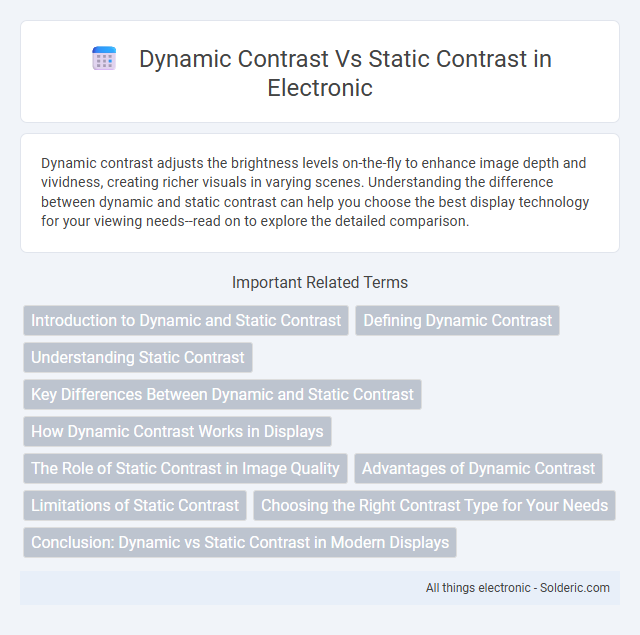Dynamic contrast adjusts the brightness levels on-the-fly to enhance image depth and vividness, creating richer visuals in varying scenes. Understanding the difference between dynamic and static contrast can help you choose the best display technology for your viewing needs--read on to explore the detailed comparison.
Comparison Table
| Feature | Dynamic Contrast | Static Contrast |
|---|---|---|
| Definition | Contrast ratio that varies based on image content by adjusting backlight or brightness. | Fixed contrast ratio measured between the brightest white and darkest black under standard conditions. |
| Measurement | Calculated in real-time during display operation. | Measured using standardized test patterns. |
| Typical Values | Can reach very high ratios (e.g., 1,000,000:1 or more). | Ranges from 1000:1 to 3000:1 on most displays. |
| Reliability | Often marketing-driven and less consistent in real usage. | More reliable and consistent metric for display quality. |
| Impact on Viewing | Improves perceived black levels on mixed or dark scenes. | Represents true panel capability for black and white differentiation. |
Introduction to Dynamic and Static Contrast
Dynamic contrast refers to the difference between the darkest black and brightest white that a display can produce in real-time, adjusting continuously based on the content shown. Static contrast measures the ratio between the darkest black and brightest white a screen can display at a single moment without change. Understanding the distinction is crucial for evaluating display performance, as dynamic contrast reflects adaptability in varying scenes, while static contrast indicates inherent screen capabilities.
Defining Dynamic Contrast
Dynamic contrast refers to the varying ratio between the brightest and darkest parts of a display that changes in real-time based on the content being viewed, enhancing the overall visual depth and detail. Unlike static contrast, which measures the fixed luminance difference between black and white on a screen, dynamic contrast adapts to scenes by adjusting backlight intensity or pixel brightness. This technology is crucial for improving image quality in LCD and LED displays, providing richer blacks and more vivid highlights.
Understanding Static Contrast
Static contrast refers to the fixed difference between the darkest black and brightest white a display can produce, measured as a ratio (e.g., 1000:1). This ratio indicates the range of luminance a screen maintains under consistent lighting conditions without image changes. Understanding static contrast is crucial for assessing display quality, as higher static contrast ratios improve image depth, color accuracy, and overall viewing experience in static scenes.
Key Differences Between Dynamic and Static Contrast
Dynamic contrast measures the ratio between the brightest and darkest parts of an image, adjusting continuously in real-time to enhance visual depth and detail, while static contrast remains constant, defined by the fixed difference between the screen's darkest black and brightest white at all times. Dynamic contrast improves visibility in varying lighting environments by adapting brightness levels, whereas static contrast is essential for maintaining image clarity under consistent conditions. The key difference lies in dynamic contrast's ability to modulate image contrast on-the-fly versus static contrast's fixed parameter that affects overall picture quality.
How Dynamic Contrast Works in Displays
Dynamic contrast enhances display quality by continuously adjusting the backlight intensity to match the content's brightness, resulting in deeper blacks and brighter whites. This real-time modulation improves the perceived contrast ratio beyond the static contrast limit, which measures the fixed difference between the darkest black and brightest white a display can produce. Understanding how dynamic contrast works helps you optimize your viewing experience, especially in varying lighting conditions.
The Role of Static Contrast in Image Quality
Static contrast plays a crucial role in image quality by determining the difference in luminance between the darkest blacks and the brightest whites on a display. Higher static contrast ratios provide clearer details and richer colors, enhancing the overall viewing experience without fluctuations caused by ambient light or content changes. For your visual content, maintaining a strong static contrast ensures consistent, sharp images with vivid depth and realistic textures.
Advantages of Dynamic Contrast
Dynamic contrast enhances image depth by continuously adjusting the backlight intensity, resulting in richer blacks and brighter whites compared to static contrast, which remains constant. You benefit from improved detail in both dark and bright scenes, making dynamic contrast ideal for watching movies or playing video games. This adaptive technology reduces eye strain and delivers a more immersive visual experience.
Limitations of Static Contrast
Static contrast is limited by its fixed ratio between the darkest black and brightest white a display can produce, often resulting in less vivid images in varying lighting conditions. This constraint affects Your viewing experience, as details may be lost in shadows or highlights, reducing overall image depth. Dynamic contrast attempts to overcome these issues by adjusting brightness levels in real-time to enhance perceived contrast.
Choosing the Right Contrast Type for Your Needs
Dynamic contrast adjusts the difference between the darkest and brightest areas in real-time, enhancing image depth for video and gaming applications. Static contrast remains constant, providing consistent image quality ideal for professional photo editing and graphic design. Selecting dynamic contrast suits users seeking vivid motion visuals, while static contrast benefits those requiring accurate color representation and detail stability.
Conclusion: Dynamic vs Static Contrast in Modern Displays
Dynamic contrast enhances image quality by adjusting brightness levels in real-time to produce deeper blacks and brighter whites, improving visual depth and detail in varying scenes. Static contrast, defined by the inherent ratio between the brightest and darkest display output at a fixed backlight level, provides consistent baseline performance without real-time adaptation. Modern displays increasingly rely on high dynamic contrast ratios through advanced technologies like local dimming and OLED panels, offering superior contrast perception compared to static contrast limitations.
Dynamic Contrast vs Static Contrast Infographic

 solderic.com
solderic.com